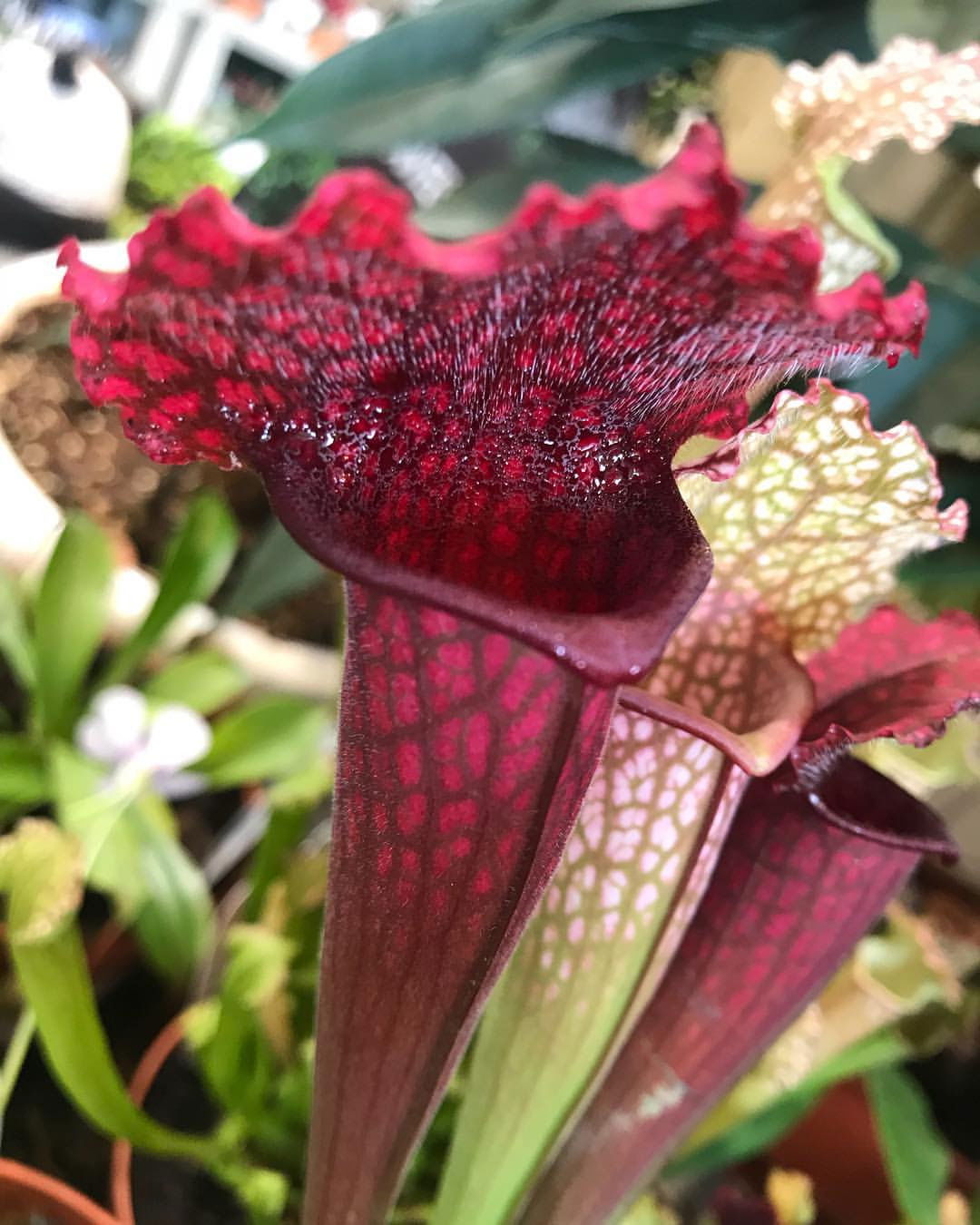
Sarracenia leucophylla
Contents
- Introduction
- Top Tips
- Location, Water, Humidity & Fertilisation
- Dormancy Care
- Common Issues
- Origins, Temperature, Propagation, Repotting & Toxicity.
Need the answer to a specific plant query? Book a 1-to-1 video call with THE HOUSEPLANT DOCTOR™, the website's friendly author, to overcome and address your niggling problem! Available on iMessage, WhatsApp, Facebook Messenger & more.
Introduction
To get the most out your specimen and this article, learning about how a Pitcher Plant functions is an excellent place to start. Many people will have a vague idea of how the mechanics of the plant works; however, the science behind this is much more enjoyable. The insect is lured into the hollow chamber via its smells of sweet nectar and bright colours. Once inside, the slippery surface and downward-pointing hairs will cause the prey to cascade into a pool of liquid, where it'll instantly sink and drown in digestive-acid. The detailed Pitcher heads are created by a cluster of window-like structures, formed from groups of chlorophyll-deficient cells that enables light into the chamber, enticing the insects to enter.
Top Tips & Info
- Care Difficulty - Easy
- Maintain evenly moist soil all of the time, averting the risk of short-lived droughts.
- A few hours of either morning or evening sun is highly beneficial. Avoid situating the Pitcher in any other location as crown rot and death are common issues among dark settings.
- Feed one live insect a week, reducing this to monthly in the autumn and winter. Do not over-feed or give the specimen any other plant-fertiliser as it'll lead to root burn and death. Place the specimen outside during the spring and summer for it to catch its prey and regain its health.
- Repotting is a rare practice for carnivorous plants, as their root systems tend to be quite sparse. Only use a 'Carnivorous' labelled potting mix during a transplant, as anything else will contain too many chemicals that'll lead to fertiliser-burn.
- If possible, keep the Pitchers outdoors in a sheltered location once the nighttime temperatures are above 10⁰C (50⁰F). Its growth rate and overall health will immensely benefit from the fresh insects and good lighting.
- The most common pest with Pitcher Plants are Spider Mites which will inhabit the cubbyholes of the foliage. Click on this link to learn more about identifying and addressing these Mites.
- It's entirely reasonable for a loss of Pitchers (leaves) over the winter months; as long as there's still a few healthy leaves leftover, it'll bounce back in the spring in no time!
- Why not buy our premium Carnivorous Soil Mix here? We have sold over 1,200 batches in the last year alone, so click here to find out more...
Location & Light - 🔸🔸🔸
It's mandatory to provide a location that offers a few hours of morning or evening sunlight. Settings that are too dark will result in yellowed lower leaves, slowed growth and a tendency to adopt root rot.
Situate the plant outdoors in a sheltered location once the nighttime temperatures surface above 10⁰C (50⁰F) to catch its prey. A short spell outside will significantly improve the overall health, as well as weakened or dying specimens making a near-full recovery. Maintain evenly moist soil and return indoors once the temperatures dip below this threshold.
Water - 🔸🔸🔸
This genus must sit in continual moist soil, with specimens left outside or near a window being monitored frequently. Never to pour water directly in the Pitchers as they'll self-regulate the enzymes and liquids secreted over the course of the week. Under-watering symptoms include browned leaf-tips, stunted growth and rapidly declining foliage - be sure to place the pot around 1cm deep in water to counteract dehydration. Those situated in brighter areas will have their compost dry significantly quicker than others in cool, darker settings. Over-watering symptoms include a rotten crown, mouldy soil and yellow or brown lower leaves. Take the specimen out of its pot and inspect its root health; if you feel that root rot has taken over, be sure to visit this link.
Which are the best types of water to use on a Sarracenia Pitcher Plant are:
- Rainwater (dirty looking water is fine!)
- Deionised water
- Distilled water
- Water from a dehumidifier
If you don't have access to these waters, try boiling tap water and sitting it on the side for 12 hours, before running it through a Brita-style filter.
Which are the worse water Types? Do NOT Use:
- Pond water that is high in nitrates (fish excrement)
- Bottled mineral or spring water (or if it's high in lime).
Humidity - 🔸🔸
Create a humidity tray to provide a moist and stable environment. If the surrounding saturation is too low or the heat too high, its foliage may start to brown over and curl at the tip, especially in strong light. Hose the foliage down from time to time to hydrate the leaves and keep the dust levels down, but NOT directly into the Pitchers.
Fertilisation - 🔸🔸
Many people panic over what to feed their plant. Natural prey like spiders, flies, mosquitoes and even slugs are the only food that they should digest. Never feed them cake, meat or stones as this will kill the individual Pitcher or even spell the end of the plant's life. Dead insects should be avoided too, as the trichomes can detect whether or not there's something inside it, and if the prey doesn’t move, digestion won't take place. The final point to mention is never to allow it to digest something bigger than one-third of the Pitchers' size; the lips won't be able to shut entirely, thus wasting vital energy in the process.
Keep the plant outside once the nighttime temperatures are above 10⁰C (50⁰F) so that it can catch its own prey. There's nothing better for a carnivorous plant than to allow it to breathe, digest, and photosynthesise in the fresh outdoors without human intervention.
Dormancy Care
The final element for a long-lasting carnivorous plant is a vital resting period during the autumn and winter months. While keeping the soil moist, reduce insect-feeds to almost none, as in the wild airborne prey tend to be less in numbers during this time. Reduce the ambient temperature to around 12℃ (54℉) during the night to reinforce this critical period - even a cool windowsill will be sufficient enough. If its dormancy is served well, you'll be rewarded with a flurry of juvenile growth towards the start of spring season.
Those that don't serve an adequate dormancy period will show signs of weak spring growth, along with a shorter life span.
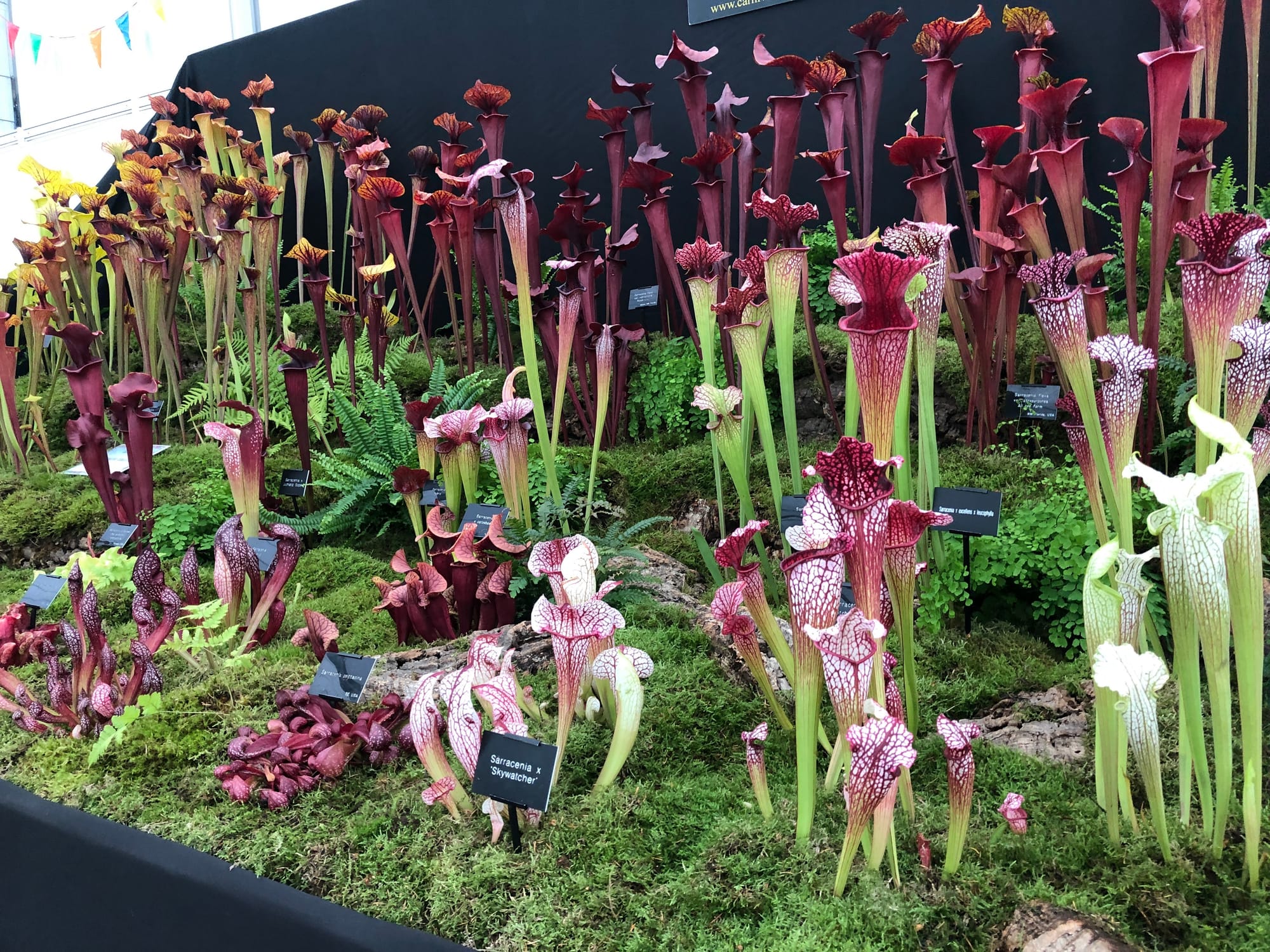 Sarracenia love to be kept in reliable moisture, similar to conditions found in bogs or wetlands. Here's an ideal depiction of how they look in the wild.
Sarracenia love to be kept in reliable moisture, similar to conditions found in bogs or wetlands. Here's an ideal depiction of how they look in the wild.
Common Issues with Pitcher Plants (Sarracenia)
Spider Mites are small, near-transparent critters, that'll slowly extract the chlorophyll from of its leaves. Have a check around the leaves, most notably along the midrib, for small webs and gritty yellow bumps. Click here to read our article about the eradicating Spider Mites, along with some extra tips that you may not find elsewhere!
Too little light accompanied by water-logging will cause the lower leaves to rapidly yellow and rot. Although this is a natural response to ageing on a smaller extent, persistent yellowing and a near absence of foliage should only occur during the winter. If this is the case during the height of summer, action must be taken immediately. Place the plant in a location that receives little direct sunlight out of peak hours, or outside if possible. Although it will take several weeks for the plant to start to recover, better-growing conditions with the occasional insect will significantly benefit its overall health. Other causes for yellowing leaves are sun-scorch or the use of a non-carnivorous potting mix. Pitcher Plants must not be repotted into any other compost, as the chemicals will quickly lead to root-burn and inevitable death.
Under-developed or deformed Pitchers are caused by persistent under-watering or too much sunlight. Dry soil must be avoided at all times for success as they grow naturally in bog climates across the world. After a few weeks of moist environment, better growth should start to develop.
Complete dehydration will cause the foliage to crisp up and die. Instead of discarding the plant, remove all of the affected leaves and maintain moist soil. Sarracenia have a modified stem, whereby its 'rhizome' will still store enough energy to reproduce new foliage. Have a look at the image below to learn more.
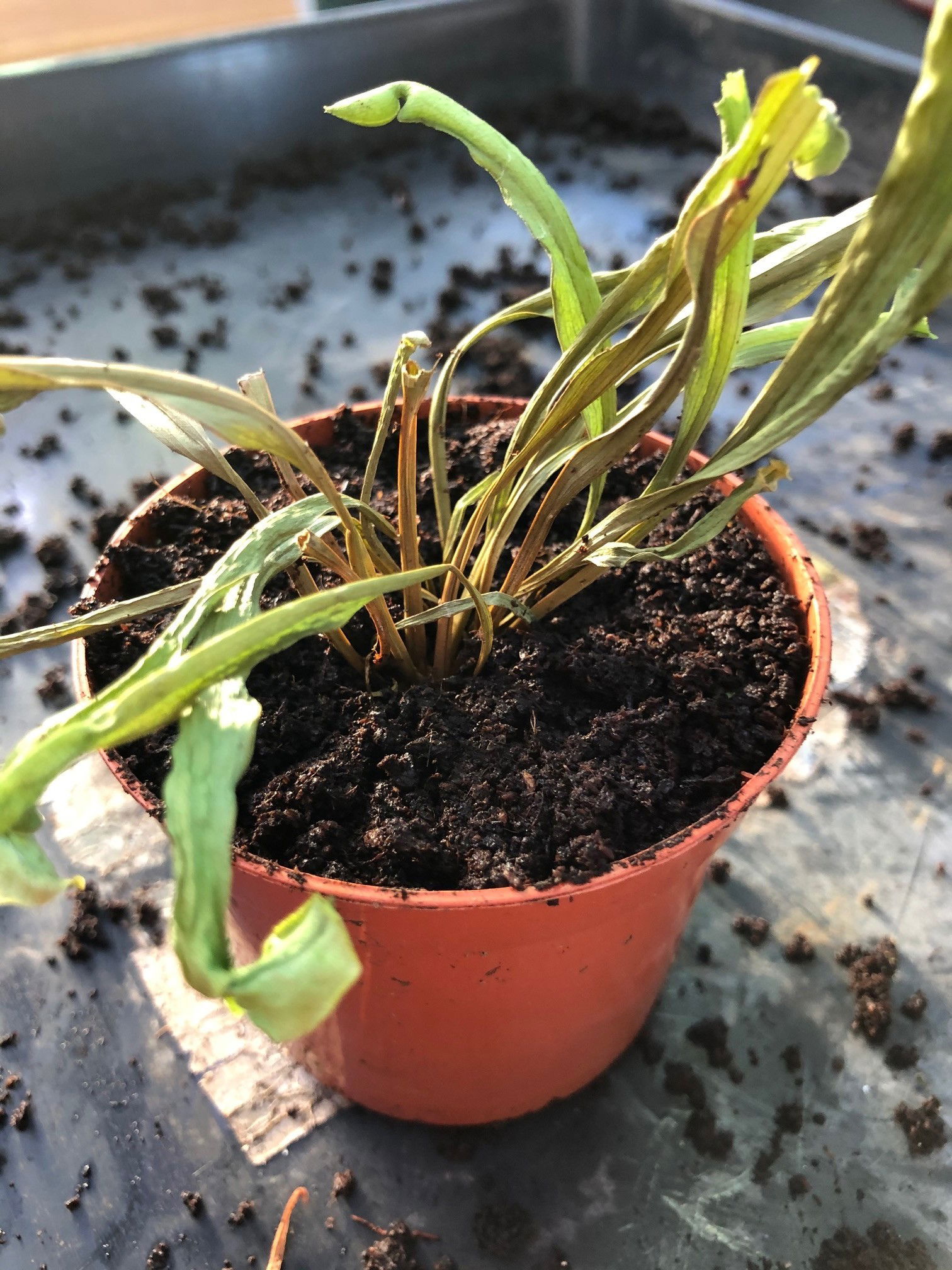 A dehydrated Sarracenia.
A dehydrated Sarracenia.
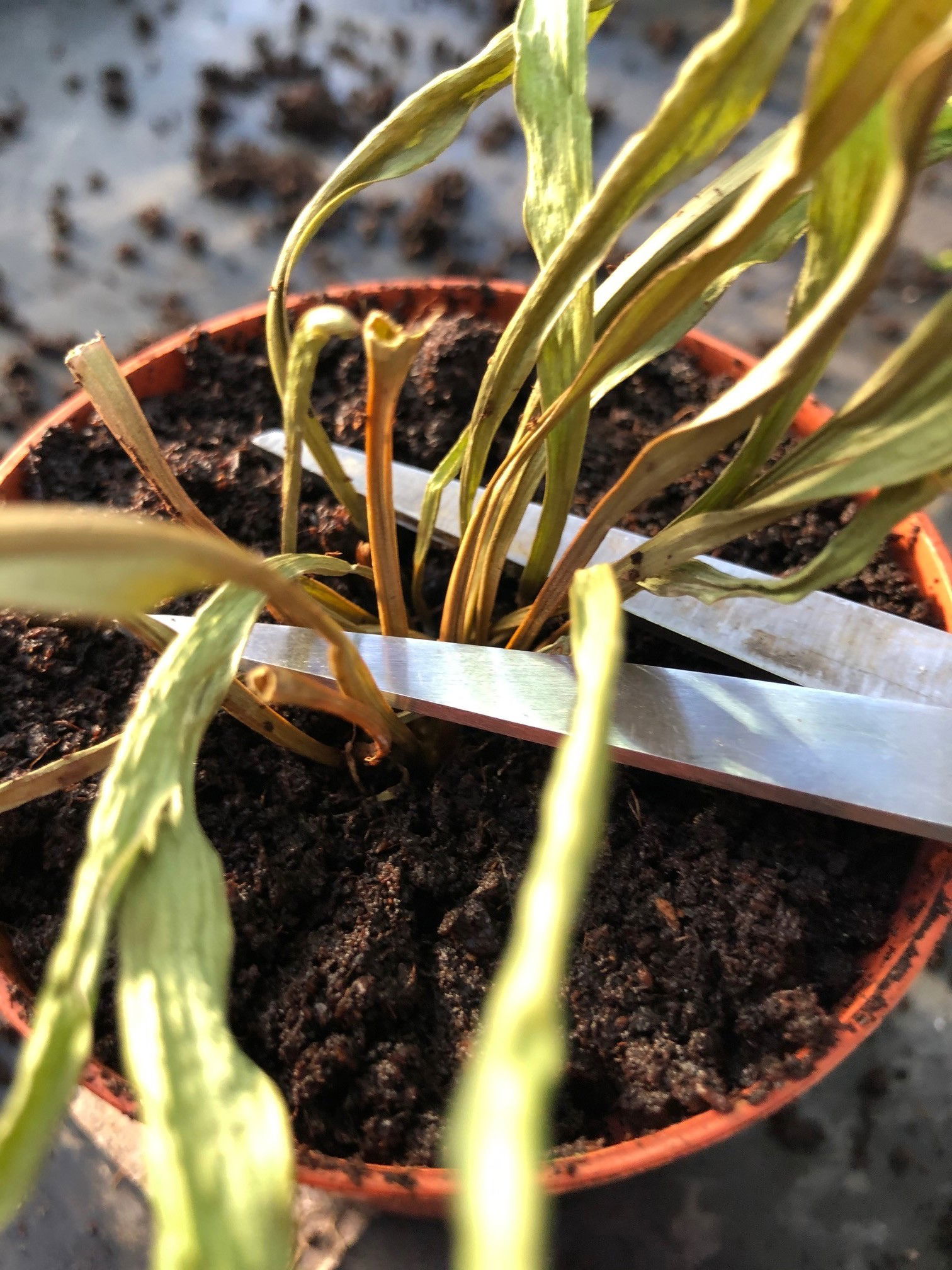 Cut the foliage an inch above the soil line, to expose its 'rhizome' - a swollen stem that stores energy and moisture.
Cut the foliage an inch above the soil line, to expose its 'rhizome' - a swollen stem that stores energy and moisture.
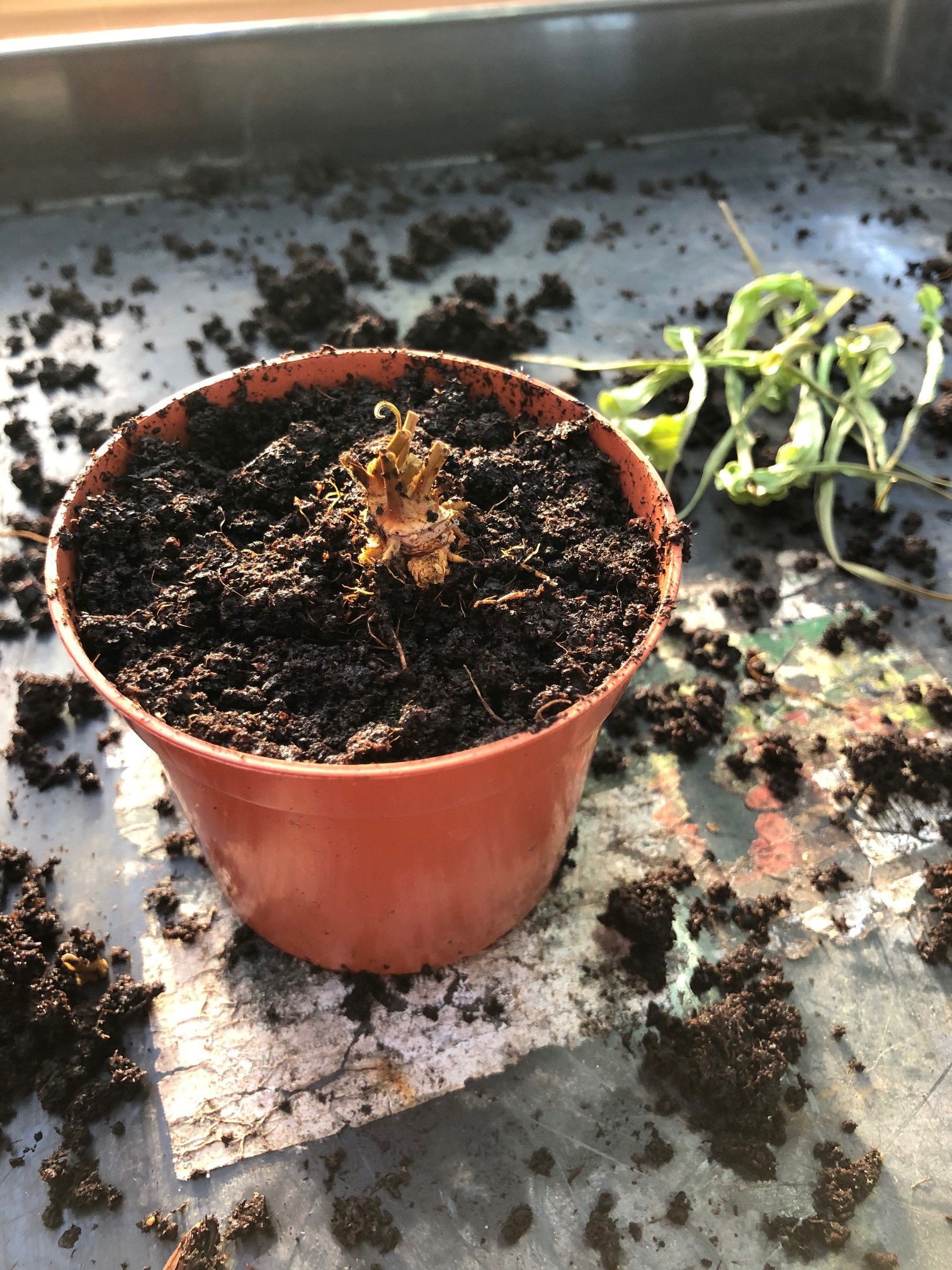 Keep the plant in a cool, bright environment until new growth forms at the base.
Keep the plant in a cool, bright environment until new growth forms at the base.
Cold tap water will quickly damage the plant with foliage-loss and stunted growth. The cold temperatures and high levels of chloride typically found with taps water should be replaced by either rainwater or fresh bottled water. If you were to use water from the tap, help the situation by allowing it to stand for 24hrs in a non-mental container before application.
Too much sunlight will lead to sun scorch, with typical signs including browning or crispy leaves, dry leaf-edges, sunken leaves or stunted growth. Although too little light will cause over-watering issues, excess sunlight will be a detriment to the plant as well. If yours has fallen short of this, reduce the amount of the sun considerably and always be mindful of environmental shock (when two locations offer too different growing conditions). Remove some of the affected leaves and increase waters slightly.
Mould developing on the soil means two things - too little light and over-watering. Despite the harmlessness, it'll prove unsightly to most gardeners and is therefore removed once known. To remove, replace the top two inches of the soil for a fresh batch of carnivorous-labelled compost. Either increase the amount of light received (no direct sunlight for the first few weeks to prevent environmental shock) or decrease the frequency of waters slightly. If the mould is accompanied by yellowing lower leaves, you may also have a case of root rot.
Origins
Although Sarracenia were first known to European botanists in the 1500s, they lacked exact taxonomy until Michel Sarrazin (who the genus was named after) sent live specimens to a Parisian botanist, Joseph Pitton de Tournefort in the late 17th-century for classification. Their natural distributions largely remain on the eastern side of North America but have later been introduced in areas such as the Lake District in England, Switzerland and Germany. Unfortunately, those grown in regions of south U.S. risk extinction as over 97% of the species' natural habitat has been destroyed for urban development and forestry drainage.
The most popular species, S. leucophylla, was first described by Constantine Rafinesque-Schmaltz in 1817, using the Greek word for colourless (λευκός) that refers to the species' lack of distinctive colour.
S. purpurea was classified by Carl Linnaeus in 1753, using the species' typical purple-tipped Pitchers for the name's inspiration. He also classified S. flava that refers to its 'blond' coloured foliage.
S. rubra is the Latin word for 'red' and was formally described by Thomas Walter 1788.
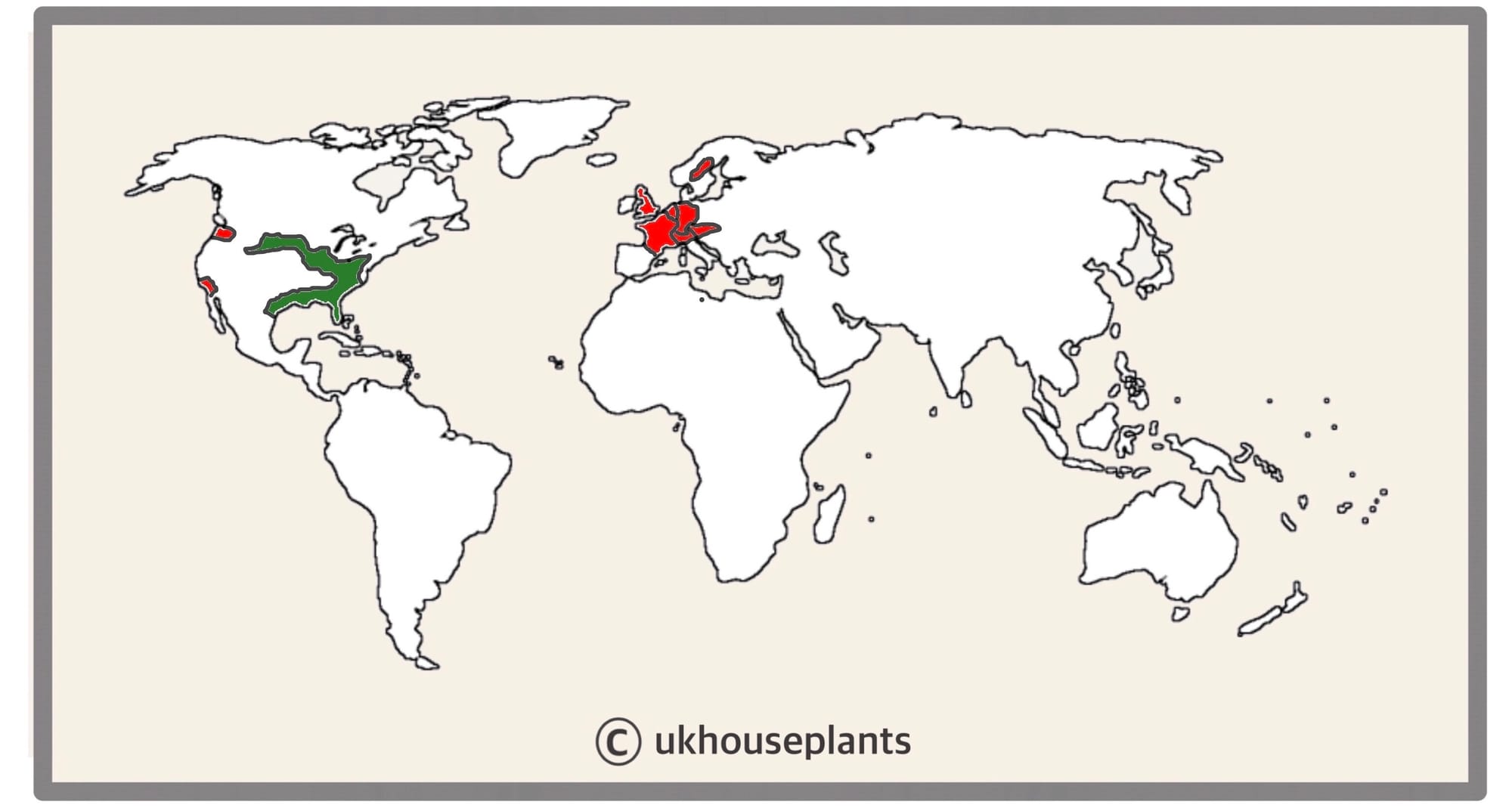 The Distribution of Sarracenia in Green & Its Introduction in Red.
The Distribution of Sarracenia in Green & Its Introduction in Red.
Temperature
10° - 38°C (50 - 100°F)
H1c (Hardiness Zone 11) - Can be grown outdoors between late spring and summer throughout most of the UK while nighttime temperatures are above 8℃ (46℉). If you decide to bring the plant outdoors, don't allow it to endure more than an hour of direct sunlight a day as it may result in sun-scorch. Regularly keep an eye out for pests, especially when re-introducing back indoors.
Spread
Over 1m in height and 40cm in width once maturity is reached. The ultimate height will take around 5 years to achieve, but can live for over 10 years in the right conditions.
Pruning & Maintenance
Remove yellow or dying leaves, and plant debris to encourage better-growing conditions. While pruning, always use clean utensils or shears to reduce the chance of bacterial and fungal diseases. Never cut through yellowed tissue as this may cause further damage in the likes of diseases or bacterial infections. Remember to make clean incisions as too-damaged wounds may shock the plant, causing weakened growth and a decline in health.
Propagation
Via Seed or Basal Offset Division.
Seeds (Easy) - The only soil you can use is a 'Carnivorous' labelled compost, as other mixes will retain too many chemicals that'll burn the cases of the seeds. Set the seeds on top of the soil's surface, resisting the temptation to compact it. Maintain evenly moist compost and allow the excess water to freely drain from the pot's base to prevent water-logging. The ideal location for successful germination is in a bright, indirect setting with temperatures above 18℃ (64℉) with bottom-heat. Keep the pot in a transparent bag to provide a stable level of humidity, along with longer-lasting soil moisture. Germination may take up to three months, so don't discard any unsuccessful seeds until this threshold has been surpassed. Remove the bag once the seedlings produce their second leaf and then split them into their own 5cm (2 inches) pots after a further month.
Basal Offset Division (Easy) - Your plant will produce several offsets that can be separated once they have a sufficient root system, with the biggest Pitcher surpasses 8cm. If possible, water the soil 24hrs before the main event to reduce the risk of transplant shock, when its dry root systems are over-fingered. Take the plant out of its pot and place your fingers close to the nodal junction - compost may have to be removed for better access. Push the chosen offset downwards until you hear a snap. Separate the foliage and its root system away from the mother plant, mentally noting the high risk of damage. Transplant in the appropriate sized pot with a fresh batch of 'Carnivorous' soil. Maintain evenly moist soil and situate it in a bright, indirect location away from any direct sunlight. After four weeks, treat it like a healthy specimen, following the care tips above!
Flowers
Blooms will appear in early spring, typically ahead of the first Pitcher development. The design of the flower is elaborate, with extensive detail in the avoidance of self-pollination. The flower has evolved to hang upside down, similarly to the Cyclamen, with its filament hanging from the ceiling and a platform-shaped 'style' to catch the pollen. The insect will land on the 'style' which guises itself like a chamber and landing-pad, and for it to access the nectar, it will have to brush past the dangling stamens. Upon exiting, the insect will have to push its self under a trap-like petal, therefore staying away from the stigma entirely.
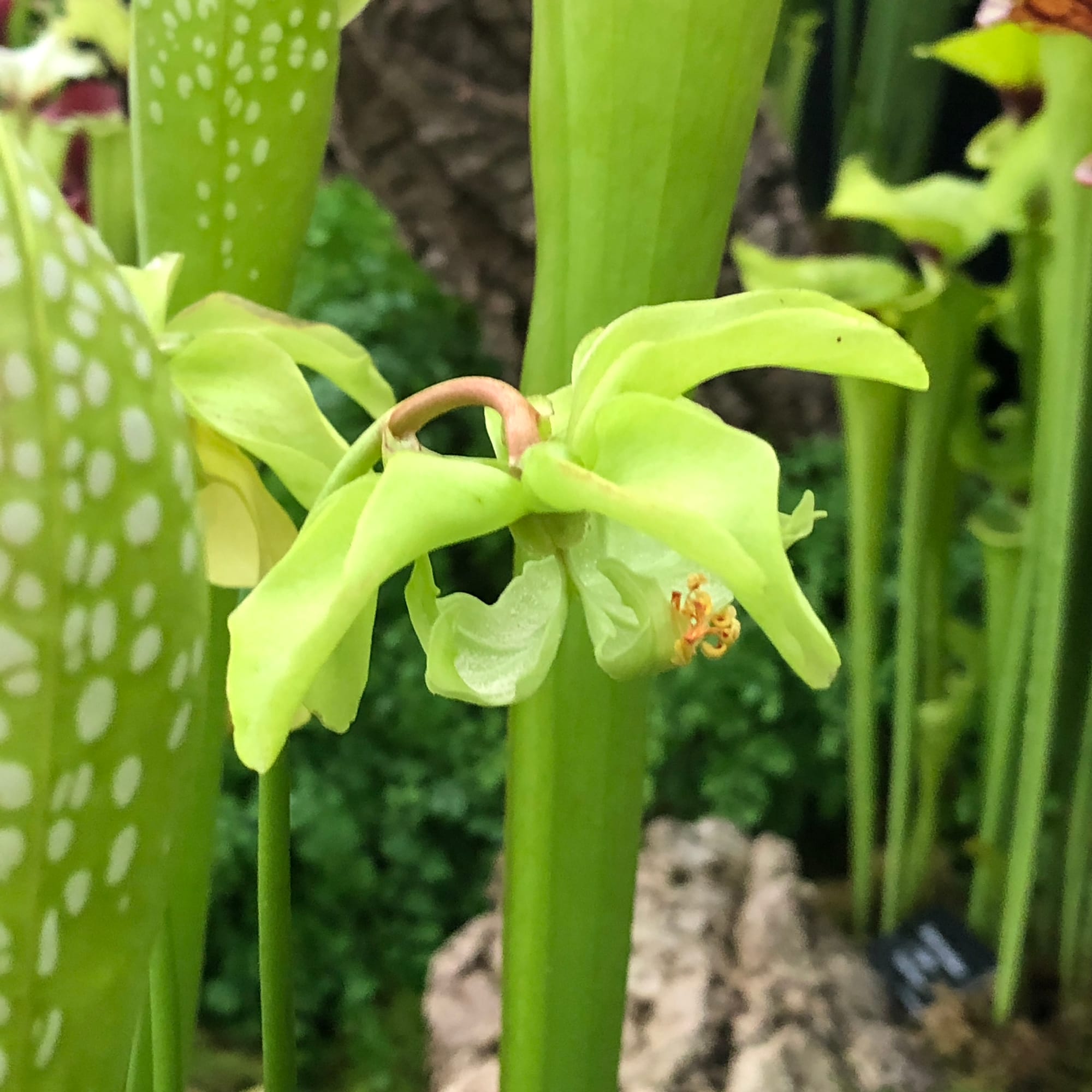
Repotting
Repot every three years in the spring, using only a 'Carnivorous' labelled compost and the next sized pot with adequate drainage. Hydrate the plant 24hrs before tinkering with the roots to prevent the risk of transplant shock. If you're still unsure of what to do, never hesitate to send us an email or direct message to get our expert advice on transplantation. Never use any other compost as the chemicals typically found in these soils will burn the roots, killing the plant outright.
Book a 1-to-1 video call with THE HOUSEPLANT DOCTOR™ if you'd like a personal guide to repotting your houseplant. This will include recommending the right branded-compost and pot size, followed by a live video call whilst you transplant the specimen for step-by-step guidance and answer any further questions!
Pests & Diseases
Keep an eye out for mealybugs, aphids, spider mites, scale, blackfly, soil mites & root mealybugs that'll locate themselves in the cubbyholes and undersides of the leaves, with the exception of the latter two in the soil. Common diseases associated with Pitcher Plants are root rot, leaf-spot disease, botrytis, powdery mildew & southern blight - click here to learn more about these issues.
Toxicity
Not known to be poisonous when consumed by pets and humans. If large quantities are eaten, it may result in vomiting, nausea and a loss of appetite.
Retail Locations
Dobbies, Online Stores.
Book a 1-to-1 Call with THE HOUSEPLANT DOCTOR™
If you need further advice with your houseplants, book an advice call with ukhouseplants' friendly and expert writer today! This can be done via a video or audio call on most apps, including Facebook, FaceTime & Skype. A ten-minute call costs £5.99 (US$7), or £15.99 for thirty minutes. You can ask multiple questions, including queries on plants, pests, terrariums, repotting advice and anything in between. Please consider supporting this service to keep ukhouseplants thriving!